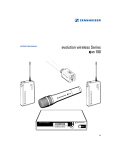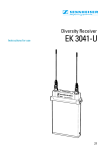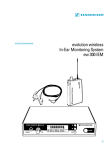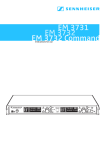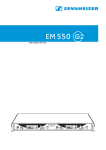Download Sennheiser EM 3532-U Technical data
Transcript
EM 3532-U Instructions for use 38 Chapter Contents ............................................................................................................................. Page 1 Brief description, special features ........................................................................... 40 2 Connections and operating elements ..................................................................... 41 3 Noise reduction with HiDyn plus™ .......................................................................... 42 4 Diversity reception .................................................................................................. 43 5 Assembly and mounting, assembly instructions ................................................... 44 6 Connection and mounting of remote antennæ ...................................................... 46 7 Selecting the mains voltage / Mains connection .................................................... 47 8 Putting the EM 3532 into operation ...................................................................... 48 9 Basic functions of the Sennheiser operating menu ............................................... 49 10 Menus / Overview ................................................................................................... 50 11 LC display panel ..................................................................................................... 51 12 Setting a receiving frequency, allocating a frequency memory and assigning a channel number ................................................................................... 52 13 Deleting a receiving frequency, emptying a frequency memory .......................... 54 14 Setting the receiving frequency via the channel number ...................................... 55 15 Squelch (Muting) ..................................................................................................... 56 16 Advanced muting function ..................................................................................... 57 17 Automatic transmitter search tuning – Scan function .......................................... 58 18 Adding a supply voltage for antenna boosters ...................................................... 60 19 Stand-by operation .................................................................................................. 61 20 Remote control ........................................................................................................ 62 21 Power of the received RF signal ............................................................................. 63 22 Monitoring the sound signal, headphone connection .......................................... 64 23 Replacing a fuse ....................................................................................................... 65 24 Sennheiser transmitters report their battery status ............................................... 66 25 Suitable Sennheiser transmitters ............................................................................ 67 26 Error checklist ......................................................................................................... 68 27 Safety instructions ................................................................................................... 68 28 Recommended accessories ...................................................................................... 69 29 Technical Data ......................................................................................................... 70 39 Thank you for choosing Sennheiser! We have designed this product to give you reliable operation over many years. Please take a few moments to read these instructions carefully, as we want you to enjoy your new Sennheiser product quickly and to the full. 1 Brief description With the EM 3532-U twin receiver, Sennheiser offers the professional user a high-quality state-ofthe-art RF receiver with a high level of operational reliability and ease of use. The EM 3532-U receiver together with the suitable hand-held and pocket transmitters permits wireless transmission with studio-quality sound. Due to further optimised PLL and microprocessor technology and the Sennheiser patented HiDyn plus™ noise reduction system, these transmission systems surpass the signal-to-noise ratio and dynamic range of modern CD productions. The true diversity technology of the EM 3532-U receiver ensures interference-free transmission and minimises dropouts in the RF link. Especially for small television studios and theatres, the simultaneous use of several Sennheiser 3000 series receivers – such as the EM 3532-U – is an economical alternative to technically more sophisticated and therefore more expensive multi-channel systems of the 5000 series. Special features PLL microprocessor control, programmable Sennheiser HiDyn plus™ noise reduction system High transmission reliability due to true diversity reception Ease of use due to menu-assisted operation Indication of transmitter battery status and “LOW BATT” warning (only with Sennheiser transmitters transmitting battery status information) Rugged 19” 1 U metal housing Disconnectable supply voltage for external antenna boosters Remote-controllable via PC with S-MCD software External DC supply 11–18 Volt Advanced scan function / transmitter search tuning 40 2 Connections and operating elements Headphone socket 1/4 ” (6.3 mm) ø Headphone volume control Multi-function LC display panel Buttons for selecting and programming the menus SET/storage button ON / OFF switch Fuse holder and mains voltage selection 2-pin IEC mains connector Cable grip for mains cable Data interface for connecting a remote computer AF output XLR-3M, balanced Control for the AF output level at the XLR socket Antenna input B DC socket (e.g. for use in an OB van) Antenna input A 41 3 Noise reduction with HiDyn plus™ Progress you can hear: This receiver is equipped with HiDyn plus™, the Sennheiser noise reduction system that reduces RF interference. It increases the signal-to-noise ratio in wireless audio transmission to up to 110 dB. The 96 dB dynamic range of a CD is thus considerably surpassed. HiDyn plus™ is a wideband compander system which compresses the AF level on the transmitter side in a ratio of 2:1 (related to dB), and expands it in exactly the same way on the receiver side. The optimisation of the dynamic range and the supporting effect of the control amplifier in the transmitter effectively reduce modulation problems. HiDyn plus™ has been specially developed for use in high quality radiomicrophone systems. Note Only transmitters which are also equipped with HiDyn plus™ can work correctly in combination with the EM 3532-U receiver. If this is not the case, the dynamic range is drastically reduced and the transmission sounds blunt and flat. HiDyn plus™ cannot be switched off on the EM 3532 receiver. 42 AF-signal receiver 1 4 AF-signal electronic switching from one signal to another receiver 2 Diversity reception The EM 3532 receiver operates on the “true diversity” principle: A receiving antenna receives not only the electromagnetic waves which reach it by a direct path, but also the reflections of these waves which are created in the room by walls, windows, ceilings and fittings. When these waves are superimposed, destructive interference occurs, which can also be called “field strength gaps”. Repositioning the receiving antenna can bring a solution, provided the transmitter remains in its original position. With mobile transmitters, however (which all radiomicrophones are ), the “field strength gap“ will then occur with a different transmitter position. These “field strength gaps“ can only be eliminated with true diversity receivers. In true diversity, instead of one antenna and one receiver there are now two antennæ and two receiver sections. The antennæ are spatially separated. By means of a comparison circuit, the receiver section with the strongest RF signal is always switched to the common AF output. The risk of the occurrence of “field strength gaps” in both antennæ at the same time is virtually nonexistant. The display panel of the receiver always shows whether the diversity channel switched is channel A or channel B. 43 5 Assembly and mounting Use as a stand-alone receiver When using the EM 3532 as a stand-alone receiver, it is easiest to use the supplied telescopic antennæ. They can be mounted quickly and easily to the rear of the receiver and are suitable for all applications where – good reception conditions provided – a wireless transmission system is to be used without a large amount of installation work. The best reception quality, however, is obtained by using remote antennæ (see chapter 6). To ensure that the receiver is securely mounted on a surface on which it cannot slip, four selfadhesive soft rubber feet are supplied. These feet are stuck into the recesses on the lower side of the receiver. Ensure that the recesses are clean and free from grease before mounting the feet. Note Do not use these feet if rack-mounting the receiver. 44 Mounting the receiver into a rack With the two supplied rack mount “ears”, the receiver can be mounted into a 19” rack (1 U). The rack mount “ears” are screwed to the receiver on the left and right . Note If you wish to connect the antennæ to the front side, you must pull the cables of the GA 3030-AM antenna mount through the holes on the rack mount “ears” before mouting the “ears” . The GA 3030-AM antenna mount (accessory, see chapter 28) allows the antennæ to be connected to the front of the receiver, for example if the rear of the rack is closed. Mount the antenna holders to the right and left to the handles of the receiver . The connection cables, which are firmly fixed to the antenna holders, are connected to the antenna sockets on the rear of the receiver. Assembly instructions Do not place the receiver in direct proximity to digitally controlled devices! Site the receiver as high as possible so that the receiving antennæ have a “free line of sight” to the transmitter antennæ! 45 6 Connection and mounting of remote antennæ If the receiver position is not the best antenna position for optimum reception, you can use remote antennæ and antenna boosters. These are available as accessories. The best reception quality is obtained with the Sennheiser A12 AD-UHF active antenna. Antenna and receiver can be connected with RG 58 co-axial cable. Ready made up antenna cables from Sennheiser are available as accessories with lengths of 1 m, 5 m and 10 m (see chapter 28). 씰 To supply the antenna booster integrated in the A12 AD-UHF active antenna, a supply voltage needs to be added via the antenna sockets (see chapter 18). 씰 External AB 1036-TV antenna boosters can be used for compensating for cable losses if the remote antennæ are at a long distance from the receiver. The antenna boosters are connected in the antenna cable line and can be supplied with the DC supply voltage by the EM 3532 via the antenna cables. Essential notes on mounting the antennæ Position antennæ in the same room in which the transmission takes place! Maintain a minimum distance of 1 metre from metal objects (including reinforced concrete walls)! Maintain a minimum distance of 1 metre between receiving antennæ! 46 7 Selecting the mains voltage Before you plug the mains connector into the mains, please check first of all that the receiver is set to the correct mains voltage! You can change the mains voltage by removing the fuse holder with the inserted fuse , turning it through 180° and inserting it again . The set voltage can be seen at the top of the fuse holder. Mains connection Insert the supplied mains cable into socket on the receiver and pass the cable through the cable grip . Because of the cable grip, the cable cannot slip out of socket and interrupt operation. Note A cable grip is particularly important when the receiver is permanently rack mounted. Inside the rack there are often a large number of cables - a cable grip prevents the cables from pulling each other out. 47 8 Putting the EM 3532 into operation The receivers are switched on separately with the ON / OFF switches . The respective display panel is now lit up to show that the receiver is switched on, and the standard display is shown (see chapter 11). The display “MUTE” (see chapter 15) lights up, and the RF field strength is indicated. If a suitable transmitter is already operating on this frequency, the display “MUTE” is initially lit up for about two seconds. Then the deviation is indicated (modulation, see chapter 21), and the diversity branch in use is now displayed for the first time (see chapter 4). After approx. ten more seconds, the battery status display indicates the (remaining) capacity of the transmitter’s battery or rechargeable accupack, provided the transmitter in use transmits a battery status signal (see chapter 24). Note The ON / OFF switch works in the secondary circuit of the integrated mains transformer, and thus only switches the low voltage side. By using a modern magnetic core transformer, the power consumption of a receiver of approx. 1/2 Watt when switched off is extremely low. For larger installations with several receivers, a complete mains disconnection can best be achieved by an additional common ON / OFF switch. The AF connection is via sockets on the rear. The controls control the AF signal output level. 48 9 Basic functions of the Sennheiser operating menu A special feature of the Sennheiser 3000 series is the similar operation of transmitters and receivers. In stressfull situations, for example on stage or during a live show or presentation, it is important that the receiver is easy to operate and that adjustments to the receiver settings can be made quickly and “without looking”. Therefore, the necessary operating steps for each device must be similar. Press the / buttons to select a menu: By briefly pressing the / buttons, you can jump either forwards or backwards to the next menu. Your selection is indicated by the corresponding LC dot on the right of the display panel . Press the SET button to get into the setting mode: If you now press the SET button, the corresponding display on the display panel begins to flash, indicating that you are in the setting mode of the selected menu. Press the / buttons to adjust the settings of the selected menu. Press the SET button to store the setting: To store a setting, press the SET button until “Sto” briefly appears on the display, indicating that your setting has been stored. The display then switches back to the standard display. Important: Only now is your setting stored! 씰 If you do not press the / buttons or the SET button for more than 30 seconds, the setting mode is automatically left and the display switches back to the standard display. You can discontinue your preselection by briefly (!) pressing the SET button. The display briefly indicates “ESC” and then switches back to the standard display. 49 10 Menus / Overview FREQUENCY indicates the current receiving frequency. ( chapter 12) CHANNEL indicates the currently assigned channel number. ( chapter 14) SQUELCH indicates the squelch threshold. ( chapter 15) SCAN scans for available RF signals, the receiving frequency found is shown on the display. ( chapter 17) BOOSTER FEED indicates whether the supply voltage for active antennæ or antenna boosters is switched on or off. ( chapter 18) STANDBY indicates whether the receiver is set to stand-by operation. All menus – except for “REMOTE” and “STANDBY” – are then locked. ( chapter 19). REMOTE indicates whether the receiver is set for “computer remote control only”. ( chapter 20). 50 11 LC display panel Display for the “FREQUENCY” menu. This display can be the receiver’s standard display which always appears after switch-on. Display for the “BOOSTER FEED” menu. Display for the “CHANNEL” menu. This display can also be the receiver’s standard display which always appears after switch-on. Display for the “STANDBY” menu. Alphanumeric main display, indicates the settings that can be adjusted in the menus. Ten-step bargraph for the received RF signal, with overmodulation display (Peak). Ten-step bargraph for the received AF signal, with overmodulation display (Peak) and “peak hold”. Six-step bargraph for the transmitter battery status (in %) and “LOW BATT” display if transmitter battery is going flat. Antenna A is currently receiving (diversity selection). Display for the “REMOTE” menu. Reception is muted, “MUTE”. Antenna B is currently receiving (diversity selection). Menu selection with display via LC dots. 51 12 Setting a receiving frequency, allocating a frequency memory and assigning a channel number The EM 3532 receiver has a switchable frequency memory to store a maximum of 32 receiving frequencies with their respective channel numbers. The storing procedure is similar for each entry or modification: 씰 Press the / buttons to select the “FREQUENCY” menu. Then press the SET button. The “FREQUENCY MHZ” display on the display panel begins to flash: 씰 With the / buttons you can now select a different frequency. The display jumps to the next frequency in 5-kHz steps: 씰 When you get to the desired frequency, press the SET button until “Sto” briefly appears on the display. 씰 You now have to check whether the frequency memory (nos. 1 to 32) is allocated correctly. The display indicates the receiving channel with the allocated frequency memory, and the “CHANNEL” display lights up. The display for the frequency memory begins to flash. 52 씰 With the / buttons you can now select a frequency memory (nos. 1 to 32). If the frequency memory has been assigned a channel number, this is also indicated. If no channel number has been assigned, three “hyphens” appear on the display, indicating that the frequency memory is empty (see chapter 13). 씰 Have you set the frequency memory correctly? Press the SET button until “Sto” briefly appears on the display. 씰 You now have to assign the frequency memory a channel number (from 001 to 255). With larger systems, it is recommended to use the same channel numbers for both transmitters and receivers in order to provide for simpler monitoring of the system. With the / buttons you can now select the desired channel number: 씰 Have you set the channel number correctly? Press the SET button until “Sto” briefly appears on the display. The display then switches back to the standard display. Only now does the receiver change to the new frequency / channel. For some countries, this menu is locked via a special configuration program, since not all tunable receiving frequencies are approved in these countries. If the “FREQUENCY” menu is selected, “Loc” appears on the display. 53 13 Deleting a receiving frequency, emptying a frequency memory 씰 You can empty a frequency memory if you enter three “hyphens” when assigning a channel number. 씰 The last frequency stored cannot be deleted. If you try to delete the last frequency stored, the display briefly indicates “LASt” and then switches back to the standard display. You can discontinue the programming of this menu by briefly (!) pressing the SET button. The display briefly indicates “ESC” and then switches back to the standard display. The previous settings are kept. If you do not press any of the three programming buttons for more than 30 seconds, the setting mode is automatically left. The display briefly indicates “ESC” and then switches back to the standard display. The previous settings are kept. For some countries, this menu is locked via a special configuration program, since not all tunable receiving frequencies are approved in these countries. If the “FREQUENCY” menu is selected, “Loc” appears on the display. 54 14 Setting the receiving frequency via the channel number In the “CHANNEL” menu, you can directly change from one stored receiving frequency to the next. 씰 Press the / buttons to select the “CHANNEL” menu. Then press the SET button. The “CHANNEL” display on the display panel begins to flash: The display indicates the receiving frequency in alternation with the channel number. 씰 With the / buttons you can now select a different channel. The display jumps either forwards or backwards to the next channel. The next channel is not necessarily identical with the next channel number assigned! The display indicates the new channel in alternation with the receiving frequency assigned. Note If you have reached the first or the last frequency memory, the display briefly indicates “EndtAb”. Continue with your selection in the opposite direction. 씰 Have you selected the desired channel? Press the SET button until “Sto” briefly appears on the display. The display then switches back to the standard display. Only now does the receiver change to the new frequency / channel. 55 15 Squelch (Muting) The EM 3532 receiver is equipped with an adjustable squelch which eliminates annoying noise when the transmitters are switched on and off. It also suppresses sudden noise when a transmitter leaves the reception area and there is no longer sufficient transmitter power received by the receiver. The adjustment of the squelch is via the “SQUELCH” menu. The adjustment range is between 0 and 134 (on the display), which corresponds to 0 to up to 100 μV. When the squelch is active, the display “MUTE” is lit up on the display panel. If set to position “0”, the squelch is switched off. 씰 Press the / buttons to select the “SQUELCH” menu. Then press the SET button. The LC dot on the left of the text SQUELCH begins to flash and the current value of the squelch is shown on the alphanumeric main display and in the deviation bargraph. For the exact value in μV please refer to the RF level bargraph on the left of the deviation bargraph: 씰 With the / buttons you can now select a squelch threshold between 0 and 134. 씰 Only after having been stored does the new squelch treshold become effective. To store a setting, press the SET button until “Sto” briefly appears on the display, indicating that your setting has been stored. The display then switches back to the standard display. You can discontinue the programming of this menu by briefly (!) pressing the SET button. The display briefly indicates “ESC” and then switches back to the standard display. The previous settings are kept. If you do not press any of the three programming buttons for more than 30 seconds, the setting mode is automatically left. The display briefly indicates “ESC” and then switches back to the standard display. The previous settings are kept. 56 16 Advanced muting function This receiver also features AMF (Advanced Muting Function). This special electronic feature comes into effect when an RF signal drops by about 40 dB in a short time. The reception is then muted for at least three seconds. AMF thus suppresses the annoying switch-off click when a transmitter is switched off. Because of the delay in switching on again, the PLL circuit of the transmitter has enough time to adjust itself back to the corresponding transmission frequency. Example One possible area of use for AMF is the inaudible change of a hand-held transmitter. If the battery of the first transmitter has run down (display “LOW BATT” on the receiver), a second transmitter is prepared on the same frequency: insert battery, select transmission channel. Then the first transmitter is switched off, AMF switches to mute and the second transmitter is switched on. The PLL of transmitter 2 stabilises itself, AMF switches on again. The whole procedure takes place inaudibly in the background while AMF is switched to mute. Without AMF, the switching off, switching on and stabilising of the transmission frequency would have been audible in the form of possible crackles and whistling noises. AMF can be switched off. As it is coupled with the setting of the normal squelch, its function is cancelled if the squelch is set to position “0” (see chapter 15). 57 17 Automatic transmitter search tuning – Scan function The EM 3532 receiver features a scan function to scan the frequency range of the tuner for a transmitter. For some countries, this menu is locked via a special configuration program, since not all tunable receiving frequencies are approved in these countries. If the “SCAN” menu is selected, “Loc” appears on the display. 씰 Press the / buttons to select the “SCAN” menu. “SCAn” appears on the display: Then press the SET button. The current receiving frequency set appears on the display, and the “FREQUENCY MHZ” display as well as the LC dot on the left of the text SCAN begin to flash. 씰 With the / buttons you can now start the transmitter search tuning either upwards or downwards. During transmitter search tuning, the display indicates: or: 58 씰 If no transmitter is found, the search tuning stops at the upper or lower limit of the 24 MHz frequency window. The display then indicates: 씰 If a transmitter with a strong enough RF signal (higher than the squelch level, but at least 5 μV) is found, this frequency is indicated on the display. In addition, the deviation and the RF level of the received signal are indicated via the bargraphs. You can now monitor the sound signal with headphones. Information on how to store the new receiving frequency is given in chapter 12. Note If you wish to acquire data from your transmitters in use via this menu, the modulation of the transmitters must not be too high, otherwise frequency deviations may occur. The solution to this problem is simple: do not talk into the transmitter when the search tuning is activated. In general, it is best to put the transmitter down! You can discontinue the programming of this menu by briefly (!) pressing the SET button. The display briefly indicates “ESC” and then switches back to the standard display. The previous settings are kept. Note In this menu, the display does not switch back to the standard display after 30 seconds. The search tuning between the two limits of the frequency window takes about 12 – 15 seconds, and you should have time enough to write the new frequency down or to compare it with a frequency table. 씰 Press the SET button to leave this menu! 59 18 Adding a supply voltage for antenna boosters Antenna boosters can be connected to the antenna inputs of the EM 3532 receiver and can be supplied by the receiver via the antenna cables. The supply voltage can be switched on or off. Both receivers in the EM 3532 should be set to the same setting, i.e. both receiver should be set to either “On” or “OFF”! 씰 Press the / buttons to select the “BOOSTER FEED” menu. The current setting – i.e. “On” or “OFF” – is indicated on the display. Then press the SET button. The “BOOSTER FEED” display on the display panel begins to flash. You can now select your desired setting: 씰 Press the button to switch on the booster supply voltage, “On” appears on the display: 씰 Press the button to switch off the booster supply voltage, “OFF” appears on the display: 씰 Your setting has to be stored before it becomes effective. To store a setting, press the SET button until “Sto” briefly appears on the display, indicating that your setting has been stored. The display then switches back to the standard display. If the booster supply voltage is switched on, the “BOOSTER FEED” display on the display panel is lit up. You can discontinue the programming of this menu at any time by briefly (!) pressing the SET button. The previous setting is then kept. If you do not press any of the three programming buttons for more than 30 seconds, the setting mode is automatically left and the previous setting is also kept. 60 19 Stand-by operation The EM 3532 receiver can be set to stand-by operation. During stand-by operation, information from the RF section is no longer processed and the AF section is muted (MUTE). All other menus – except for “REMOTE” and “STANDBY” – are locked. If you try to select any other menu, “Loc” appears on the display. 씰 Press the / buttons to select the “STANDBY” menu. The current setting – i.e. “On” or “OFF” – is indicated on the display. Then press the SET button. The “STANDBY” display on the display panel begins to flash. You can now select your desired setting: 씰 Press the button to switch on the stand-by operation, “On” appears on the display: 씰 Press the button to switch off the stand-by operation, “OFF” appears on the display: 씰 Your setting has to be stored before it becomes effective. To store a setting, press the SET button until “Sto” briefly appears on the display, indicating that your setting has been stored. The display then switches back to the standard display. If the receiver is set to stand-by operation, the “STANDBY” display on the display panel is lit up. You can discontinue the programming of this menu at any time by briefly (!) pressing the SET button. The previous setting is then kept. If you do not press any of the three programming buttons for more than 30 seconds, the setting mode is automatically left and the previous setting is also kept. 61 20 Remote control The EM 3532 receiver can be set for “computer remote control only”. When set for remote control, all other menus – except for “REMOTE” – are locked. If you try to select any other menu, “Loc” appears on the display. 씰 Press the / buttons to select the “REMOTE” menu. The current setting – i.e. “On” or “OFF” – is indicated on the display. Then press the SET button. The “REMOTE” display on the display panel begins to flash. You can now select your desired setting: 씰 Press the button to switch on the remote control, “On” appears on the display: 씰 Press the button to switch off the remote control, “OFF” appears on the display: 씰 Your setting has to be stored before it becomes effective. To store a setting, press the SET button until “Sto” briefly appears on the display, indicating that your setting has been stored. The display then switches back to the standard display. If the receiver is set to remote control, the “REMOTE” display on the display panel is lit up. You can discontinue the programming of this menu at any time by briefly (!) pressing the SET button. The previous setting is then kept. If you do not press any of the three programming buttons for more than 30 seconds, the setting mode is automatically left and the previous setting is also kept. 62 21 Power of the received RF signal In display panel , the power of the received RF signal (in μV) and the level control of the AF signal (in %) – i.e. the modulation of the RF signal – are shown. Both displays have an overmodulation display. If the signal is too high, “PEAK” lights up briefly. Short overmodulation is not critical. Where longer overmodulation occurs, the modulation of the corresponding transmitter must be reduced. For the AF signal, “peak hold” is also shown, which means that short peaks remain visible for some time. Note If, with multi-channel systems (more than tree channels), the overmodulation display (“PEAK”) for the AF signal lights up during normal operation, the RF level should be reduced at the receivers in order to avoid intermodulation interference. In this case, increase the distance between receiving antennæ and transmitters or use attenuators in the antenna inputs. 63 22 Monitoring the sound signal, headphone connection Sockets on the EM 3532 receiver can be used to monitor the sound signal received with headphones. The headphone volume is adjusted with controls . Please use headphones with a 1/4 ” (6.3 mm) ø stereo jack plug. The sound signal itself is mono. The Sennheiser HD 25 headphone is especially usefull for this purpose. In order to judge the quality of the received sound signal even under unfavourable conditions (low AF level in the transmitter) and with high ambient noise (e.g. on the stage), the sound signal at sockets can be monitored at an amplification of up to 30 dB compared with the LINE output. For strong sound signals, however, this can distort the sound if control is turned to a high level. In this case, turn control down until the distortion disappears. If the distortion remains, the transmitter itself is overmodulated. Volume up? – No! First of all, the volume control should always be adjusted to the lowest volume (by turning it anti-clockwise as far as possible). Then turn up the volume control gradually until you have reached the desired volume. When people use headphones, they tend to choose a higher volume than with loudspeakers. Listening at high volume levels for long periods can lead to permanent hearing defects. Please protect your hearing, and as far as possible, check the sound signal only at moderate volumes. 64 23 Replacing a fuse Disconnect the receiver completely from the mains! To do so, pull out the mains connector on the receiver. You can then remove the fuse holder with the inserted fuse. Replace the fuse by a new fuse with the same rating and switch on the receiver again. Make sure that you have inserted the fuse holder the correct way round! The set voltage is shown at the top of the fuse holder. A faulty fuse should always be regarded as a warning. In most cases, the cause is harmless – a short voltage surge or some similar cause has triggered the protective mechanism. When the fuse has been replaced, the receiver works again. If the replacement fuse also blows, please consult a specialist who can discover the cause. We recommend you to contact your Sennheiser distributor or to send the receiver, with a precise description of the trouble, to a Sennheiser service department in your area. You can find the address of your nearest service department in the enclosed Service card or on the Internet at “http://www.sennheiser.com”. 65 24 Sennheiser transmitters report their battery status Sennheiser supplies hand-held and pocket transmitters which provide information on the available transmitter battery status to the receiver. This information can be evaluated with the EM 3532 receiver. The remaining battery capacity is first indicated via the six-step bargraph on the display panel . When the battery capacity is so low that only a transmission time of about 20 to 30 minutes remains, the “LOW BATT” display flashes on the display panel . You should now immediately replace the transmitter battery. The AMF (Advanced Muting Function) in the EM 3532 receiver helps you, as far as possible, to maintain the transmission without noise. Notes 씰 The “LOW BATT” display is reset by the mute function. Whenever the squelch is activated in the receiver, the “LOW BATT” display goes off and the evaluation of the battery status signal from the transmitter starts over again. 씰 Under favourable reception conditions, the evaluation of the battery information from the transmitter lasts about 10 – 20 seconds. However, it can be significantly longer if reception is subject to interference from time to time. This time is then also needed by the display in display panel in order to update the information shown. 66 25 Suitable Sennheiser transmitters For the optimum use of the excellent reception qualities of the EM 3532 receivers, Sennheiser offers hand-held and pocket transmitters in a variety of configurations: Pocket transmitters: SK 1063-U BF 1083-U SK 50-U SK 250-U (without display of battery status) (without display of battery status) (with display of battery status) (with display of battery status) Hand-held transmitters: SKM 1072-U SKM 3072-U SKM 5000-U (without display of battery status) (with display of battery status) (with display of battery status) Information on the many possible combinations of Sennheiser products and their use in multichannel systems can be found in the planning brochure “Practical Applications in RF Technology” which your Sennheiser distributor has in stock or will be pleased to order for you from Sennheiser. For up-to-date information on Sennheiser products, you can also visit the Sennheiser Web site at “http://www.sennheiser.com”. 67 26 Error checklist Error Possible cause Receiver does not work; display panel dark Receiver does not work; display panel lit up Fuse defective Transmission frequency does not agree with receiving frequency Squelch threshold adjusted too high Sound distorted AF output signal adjusted too high. Input of the connected mixing console or amplifier is overmodulated Transmission microphone overmodulated, reduce microphone sensitivity (see corresponding section in the operating manual of the transmitter) Sound overlaid with background noise Transmitter not sensitive enough; where appropriate, switch transmitter sensitivity from “low” to “high” or increase transmitter sensitivity from - 30 dB to 0 dB via operating menu (SKM 3072-U only) 27 Safety instructions Never open electronic devices! This must only be done by authorised personnel and is all the more important for current-carrying units. If devices are opened by customers in breach of this instruction, the warranty becomes null and void. Always disconnect the receiver from the mains by removing the plug when you wish to change connections or move the device to a different place. Keep the receiver away from central heating radiators and electric heaters. Never expose it to direct sunlight. Use the receiver in dry rooms only. Use a damp cloth for cleaning the receiver. Do not use any cleansing agents or solvents. 68 28 Recommended accessories Antenna mount GA 3030-AM Cat. no. 04368 Active antenna A 12 AD-UHF Cat. no. 04156 Ground plane antenna GZA 1036-9 Cat. no. 02332 Antenna booster AB 1036-TV Cat. no. 03598 Co-axial cable, 1 m GZL 1019 A1 Cat. no. 02324 Co-axial cable, 5 m GZL 1019 A5 Cat. no. 02325 Co-axial cable, 10 m GZL 1019 A10 Cat. no. 02326 BNC coupler Active antenna splitter custom-built to customer specifications GZV 1019A Cat. no. 02368 AS-X Cat. no. 03273 Monitoring headphone HD 25 Cat. no. 02976 69 29 Technical data RF characteristics Frequency range Receiving frequencies Switching bandwidth Frequency stability Sensitivity (with HiDyn plus™) Squelch treshold Image rejection Adjacent channel rejection Intermodulation attenuation Free field interference radiation 30–2,000 MHz Antenna inputs Antenna input impedance 430–960 MHz max. 32 (32 frequency memories) 24 MHz ± 10 ppm (– 10 °C to + 55 °C) < 5 μV for 90 dBA rms SNR 0 to 100 μV, adjustable ≥ 50 dB, typ. 65 dB ≥ 75 dB > 66 dB (400 kHz/800 kHz) < – 57 dBm (2 nW) 2 BNC sockets 50 Ω Modulation Compander system De-emphasis Nominal/peak deviation AF frequency response wideband FM Sennheiser HiDyn plus™ 50 μs ± 40 kHz/± 56 kHz 45–20,000 Hz AF characteristics AF outputs LINE MONITOR 3-pin XLR, transformer balanced 1 /4 ” (6.3 mm) ø jack plug (mono signal on stereo socket Signal to L- and R-ring, sleeve earthed) AF output voltage at peak deviation LINE: 0–5.6 V adjustable, ≥ 2 kΩ MONITOR: 0–2.8 V adjustable, ≥ 600 Ω Amplification on monitor output Source impedance of AF outputs Signal-to-noise ratio at 1 mVRF and peak deviation 30 dB ≤ 50 Ω (LINE at max. level) ≥ 120 dBA rms ≥ 116 dB external rms ≥ 106 dB CCIR peak ≤ 0.5 %, typ. 0.25 % THD at 1 kHz and nominal deviation Overall device Temperature range Power supply Power consumption DC supply Dimensions (without rack mount “ears”) Weight – 10 °C to + 55 °C 115/230 V AC + 10 %/– 15 % max. 15 VA 11–18 V/< 13 W 436 x 248 x 43,4 mm (19 ”, 1 U) approx. 4,000 g In compliance with standards ETS 300422 and 300445 70 Sennheiser electronic GmbH & Co. KG 30900 Wedemark, Germany Phone +49 (5130) 600 0 Fax +49 (5130) 600 300 www.sennheiser.com Printed in Germany Publ. 08/02 68746/A03




































